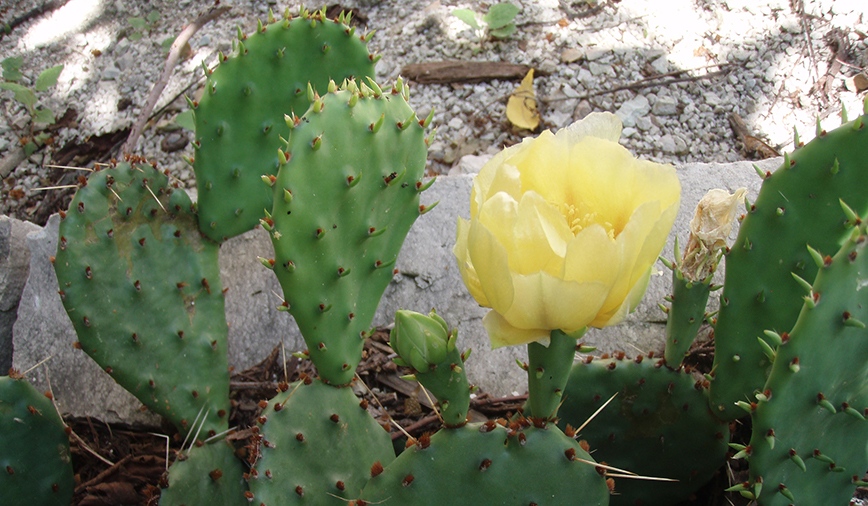My friend Kim emailed me the other day from Sedona, AZ, to tell of her 9-mile hike in the desert. She said the wildflowers are spectacular right now and, while she didn’t mention them specifically, I’m sure the cacti are too.
Today I’m going to write her back and tell her about my own hike, a 9-yard jaunt in the Native Plant Garden at Pottawatomie Park. Our wildflowers are spectacular as well, and I’ll specifically mention the cacti. They (or maybe it’s an it; I can’t exactly tell how many we have) are growing on the steps off the veranda at the back of the Pottawatomie Community Center and look positively stunning right now.
That’s right, Illinois has some cacti of its very own—the prickly pears, or Opuntia spp. While not quite as magnificent as the saguaro, those tall, long-armed, ubiquitous symbols of the Desert U.S., prickly pears are pretty impressive in their own right.
The first feature that grabs you—sometimes literally—as you walk by are the plant’s spines. Cacti have spines for a couple of reasons. One, and probably the main reason in this case, is for protection from those creatures that find cacti and their fruits appetizing.
The other reason cacti have spines is to provide shade. This function is more apparent on species like cholla and barrel cacti, which have thousands of spines and typically are found in true desert climates where the sun can be relentless. Prickly pears, on the other hand, can grow in more moderate conditions, and even places where the sun doesn’t shine (all day, that is.) Hence, its spines are spaced farther apart.
Sometimes called the Mickey Mouse cactus because of its mouse ear-shaped pads, prickly pear seeks out the sort of habitat you’d expect a cactus to prefer: sandy, rocky soil and ample sunshine. There aren’t a lot of areas in northeastern Illinois that offer that sort of combination of conditions, but one place I can think of off the top of my head is the Jon J. Duerr Forest Preserve in South Elgin. Prickly pear can indeed be found there, although there is some dispute as to whether it occurs there naturally or was transplanted years ago by a well-meaning individual.
Although our Pottawatomie prickly pear is blooming as I write this, there’s no guarantee it will still be blooming if you stop by for a look. Like this weekend’s fireworks, prickly pear blooms come and go in a flash. If you should happen to miss seeing the waxy yellow flowers, stop and admire the plant for what it is anyway—a cactus that grows in Illinois, for goodness sakes. Or, come back in a few weeks and take a look at its fleshy purple fruit—pretty in its own right, but just as spiny as its parent plant.
And tasty. Did I mention tasty? People have long used this plant’s fruit, which tastes a little bit like watermelon, to prepare jellies and syrups. Critters, too, seem to enjoy prickly pear, spines notwithstanding. In our area, those creatures are most likely to be raccoons, rabbits, deer and coyotes, although I wouldn’t put it past a hungry chipmunk or squirrel to take a bite or two.
If you happen to find yourself at Pottawatomie Park this holiday weekend, take a few minutes to stroll through the Native Plant Garden. (From the parking lot at the south end of the community center, follow the arrows on our spiffy new signs.) Find the Opuntia, and take a few minutes to appreciate its incongruent beauty. But take it easy, and maybe don’t stand too close— prickly pear is a plant you can really get stuck on!
Pam Otto is the manager of nature programs and interpretive services for the St. Charles Park District. She can be reached at potto@stcparks.org or 630-513-4346.

